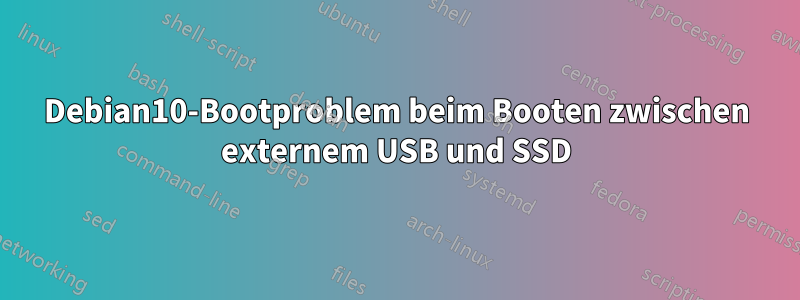
Ich habe Debian 10 auf einer internen Festplatte installiert, es hat mit dem sicheren UEFI-Boot einwandfrei funktioniert.
Wenn ich das zweite Debian auf einem externen USB-Stick installiert habe, bootet es nur von diesem USB-Stick.
Wenn ich den USB-Stick vom Laptop abziehe, um die SSD zu booten, kommt es zu einem Fehler
Minimale bash-ähnliche Zeilenbearbeitung.
Das Deaktivieren des sicheren Starts hat nicht geholfen.
Disk /dev/sda: 238,5 GiB, 256060514304 bytes, 500118192 sectors
Disk model
Units: sectors of 1 * 512 = 512 bytes
Sector size (logical/physical): 512 bytes / 512 bytes
I/O size (minimum/optimal): 512 bytes / 512 bytes
Disklabel type: gpt
Disk identifier:
Device Start End Sectors Size Type
/dev/sda1 2048 1050623 1048576 512M EFI System
/dev/sda2 1050624 1550335 499712 244M Linux filesystem
/dev/sda3 1550336 500117503 498567168 237,8G Linux filesystem
Disk /dev/sdb: 57,3 GiB, 61505273856 bytes, 120127488 sectors
Disk model: Ultra USB 3.0
Units: sectors of 1 * 512 = 512 bytes
Sector size (logical/physical): 512 bytes / 512 bytes
I/O size (minimum/optimal): 512 bytes / 512 bytes
Disklabel type: gpt
Disk identifier:
Device Start End Sectors Size Type
/dev/sdb1 2048 1050623 1048576 512M EFI System
/dev/sdb2 1050624 1550335 499712 244M Linux filesystem
/dev/sdb3 1550336 120125439 118575104 56,6G Linux filesystem
Disk /dev/mapper/sdc3_crypt: 56,5 GiB, 60693676032 bytes, 118542336 sectors
Units: sectors of 1 * 512 = 512 bytes
Sector size (logical/physical): 512 bytes / 512 bytes
I/O size (minimum/optimal): 512 bytes / 512 bytes
Disk /dev/mapper/usb--vg-root: 48,7 GiB, 52240056320 bytes, 102031360 sectors
Units: sectors of 1 * 512 = 512 bytes
Sector size (logical/physical): 512 bytes / 512 bytes
I/O size (minimum/optimal): 512 bytes / 512 bytes
Disk /dev/mapper/usb--vg-swap_1: 7,9 GiB, 8451522560 bytes, 16506880 sectors
Units: sectors of 1 * 512 = 512 bytes
Sector size (logical/physical): 512 bytes / 512 bytes
I/O size (minimum/optimal): 512 bytes / 512 bytes
lvs-Ausgabe
LV VG Attr LSize Pool Origin Data% Meta% Move Log Cpy%Sync Convert
root intern-vg -wi-a----- 229,80g
swap_1 intern-vg -wi-a----- <7,87g
root usb-vg -wi-ao---- 48,65g
swap_1 usb-vg -wi-ao---- 7,87g
Antwort1
Bitte beachten Sie, dass sich Debian 10 zum Zeitpunkt des Schreibens dieses Artikels noch im testingEntwicklungsstadium befindet und es daher hier und da noch einige Ecken und Kanten geben kann.
Ich vermute, dass das Debian-Installationsprogramm keine Ahnung davon hatte, dass die zweite Installation auf einem Wechseldatenträger erfolgen würde, und die GRUB-Kopie der ersten Installation auf Ihrer EFI-Systempartition (ESP) mit einer Kopie überschrieben hat, die für den Bootvorgang vom USB-Gerät konfiguriert war.
Zur Behebung des Problems müssen Sie zwei Dinge in beliebiger Reihenfolge tun:
1.) Sie sollten sicherstellen, dass die USB-basierte Installation selbst bootfähig ist, d. h. das USB-Laufwerk sollte eine FAT32-Partition enthalten, die eine Kopie des Bootloaders unter enthält \EFI\boot\bootx64.efi. Dadurch wird ein entfernbarer USB-Stick im UEFI-Sinne bootfähig.
2.) Um den Bootloader der Installation auf der internen Festplatte zu reparieren, können Sie die USB-basierte Installation booten, dann die Partition(en) der internen Festplatte-basierten Installation mounten und per chroot in diese Installation einsteigen.
Ihre fdisk -lAusgabe zeigt, dass wahrscheinlich auch LVM verwendet wird.
Basierend auf Ihrer fdisk -lAusgabe sollte dies der Anfang der erforderlichen Befehle sein. Beachten Sie, dass all dies als Root ausgeführt werden sollte. Verwenden Sie also zuerst entweder su -und geben Sie das Root-Passwort ein oder sudo -iund geben Sie Ihr eigenes Passwort ein, um Root zu werden.
# mkdir /mnt/hddsystem
# cryptsetup luksOpen /dev/sda3 sda3_crypt
<the above command will ask you the encryption passphrase of the HDD installation.
If successful, then /dev/mapper/sda3_crypt should now exist>
# vgscan
<this detects the LVM volume group within the encrypted container of the HDD installation>
# lvs
<this displays all the detected LVM logical volumes and their names>
# vgchange -ay intern-vg
# mount /dev/mapper/intern--vg-root /mnt/hddsystem
<if successful, directories like /mnt/hddsystem/dev, /mnt/hddsystem/proc, /mnt/hddsystem/sys
should be visible and empty at this point. Other directories should be visible under /mnt/hddsystem too.>
# mount /dev/sda2 /mnt/hddsystem/boot
# mount /dev/sda1 /mnt/hddsystem/boot/efi
An diesem Punkt könnte es auch einfach sein, den Bootvorgang des USB-Systems zu reparieren, indem Sie einfach die Version von GRUB, die nach USB-Medien sucht, um sie tatsächlich auf den USB-Stick zu booten, kopieren, bevor wir sie auf der Festplatte überschreiben.
# mkdir /mnt/usb-esp
# mount /dev/sdb1 /mnt/usb-esp
# mkdir -p /mnt/usb-esp/EFI/boot
# cp -r /mnt/hddsystem/boot/efi/EFI/debian /mnt/usb-esp/EFI/
# cp /mnt/usb-esp/EFI/debian/grubx64.efi /mnt/usb-esp/EFI/boot/
# cp /mnt/hddsystem/boot/efi/EFI/debian/shimx64.efi /mnt/usb-esp/EFI/boot/bootx64.efi
# umount /mnt/usb-esp
Zurück zum Reparieren der Festplatteninstallation ...
# mount -o bind /dev /mnt/hddsystem/dev
# mount -o bind /proc /mnt/hddsystem/proc
# mount -o bind /sys /mnt/hddsystem/sys
<these commands are preparations for the following chroot command, mounting all the necessary real and virtual filesystems so that the inactive HDD-based installation can be used like an active, running system.>
# chroot /mnt/hddsystem /bin/bash
<this command transitions us to the HDD-based environment; from this point onwards, for this shell session only, /mnt/hddsystem is /.>
# grub-install /dev/sda1
# update-grub
<these two commands to fix the bootloader are what all the preparations above were for.>


